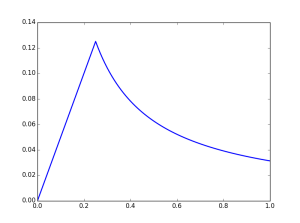[Click here for a PDF of this post with nicer formatting]
In [2] the following vector potential
\begin{equation}\label{eqn:solenoidConstantField:20}
\BA = \frac{B \rho_a^2}{2 \rho} \phicap,
\end{equation}
is introduced in a discussion on the Aharonov-Bohm effect, for configurations where the interior field of a solenoid is either a constant \( \BB \) or zero.
I wasn’t able to make sense of this since the field I was calculating was zero for all \( \rho \ne 0 \)
\begin{equation}\label{eqn:solenoidConstantField:40}
\begin{aligned}
\BB
&= \spacegrad \cross \BA \\
&= \lr{ \rhocap \partial_\rho + \zcap \partial_z + \frac{\phicap}{\rho}
\partial_\phi } \cross \frac{B \rho_a^2}{2 \rho} \phicap \\
&= \lr{ \rhocap \partial_\rho + \frac{\phicap}{\rho} \partial_\phi } \cross
\frac{B \rho_a^2}{2 \rho} \phicap \\
&=
\frac{B \rho_a^2}{2}
\rhocap \cross \phicap \partial_\rho \lr{ \inv{\rho} }
+
\frac{B \rho_a^2}{2 \rho}
\frac{\phicap}{\rho} \cross \partial_\phi \phicap \\
&=
\frac{B \rho_a^2}{2 \rho^2} \lr{ -\zcap + \phicap \cross \partial_\phi \phicap}.
\end{aligned}
\end{equation}
Note that the \( \rho \) partial requires that \( \rho \ne 0 \). To expand the cross product in the second term let \( j = \Be_1 \Be_2 \), and expand using a Geometric Algebra representation of the unit vector
\begin{equation}\label{eqn:solenoidConstantField:60}
\begin{aligned}
\phicap \cross \partial_\phi \phicap
&=
\Be_2 e^{j \phi} \cross \lr{ \Be_2 \Be_1 \Be_2 e^{j \phi} } \\
&=
– \Be_1 \Be_2 \Be_3
\gpgradetwo{
\Be_2 e^{j \phi} (-\Be_1) e^{j \phi}
} \\
&=
\Be_1 \Be_2 \Be_3 \Be_2 \Be_1 \\
&= \Be_3 \\
&= \zcap.
\end{aligned}
\end{equation}
So, provided \( \rho \ne 0 \), \( \BB = 0 \).
The errata [1] provides the clarification, showing that a \( \rho > \rho_a \) constraint is required for this potential to produce the desired results. Continuity at \( \rho = \rho_a \) means that in the interior (or at least on the boundary) we must have one of
\begin{equation}\label{eqn:solenoidConstantField:80}
\BA = \frac{B \rho_a}{2} \phicap,
\end{equation}
or
\begin{equation}\label{eqn:solenoidConstantField:100}
\BA = \frac{B \rho}{2} \phicap.
\end{equation}
The first doesn’t work, but the second does
\begin{equation}\label{eqn:solenoidConstantField:120}
\begin{aligned}
\BB
&= \spacegrad \cross \BA \\
&= \lr{ \rhocap \partial_\rho + \zcap \partial_z + \frac{\phicap}{\rho}
\partial_\phi } \cross \frac{B \rho}{2 } \phicap \\
&=
\frac{B }{2 } \rhocap \cross \phicap
+
\frac{B \rho}{2 }
\frac{\phicap}{\rho} \cross \partial_\phi \phicap \\
&= B \zcap.
\end{aligned}
\end{equation}
So the vector potential that we want for a constant \( B \zcap \) field in the interior \( \rho < \rho_a \) of a cylindrical space, we need
\begin{equation}\label{eqn:solenoidConstantField:140}
\BA =
\left\{
\begin{array}{l l}
\frac{B \rho_a^2}{2 \rho} \phicap & \quad \mbox{if \( \rho \ge \rho_a \) } \\
\frac{B \rho}{2} \phicap & \quad \mbox{if \( \rho \le \rho_a \).}
\end{array}
\right.
\end{equation}
An example of the magnitude of potential is graphed in fig. 1.
References
[1] Jun John Sakurai and Jim J Napolitano. \emph{Errata: Typographical Errors, Mistakes, and Comments, Modern Quantum Mechanics, 2nd Edition}, 2013. URL http://www.rpi.edu/dept/phys/Courses/PHYS6520/Spring2015/ErrataMQM.pdf.
[2] Jun John Sakurai and Jim J Napolitano. Modern quantum mechanics. Pearson Higher Ed, 2014.
